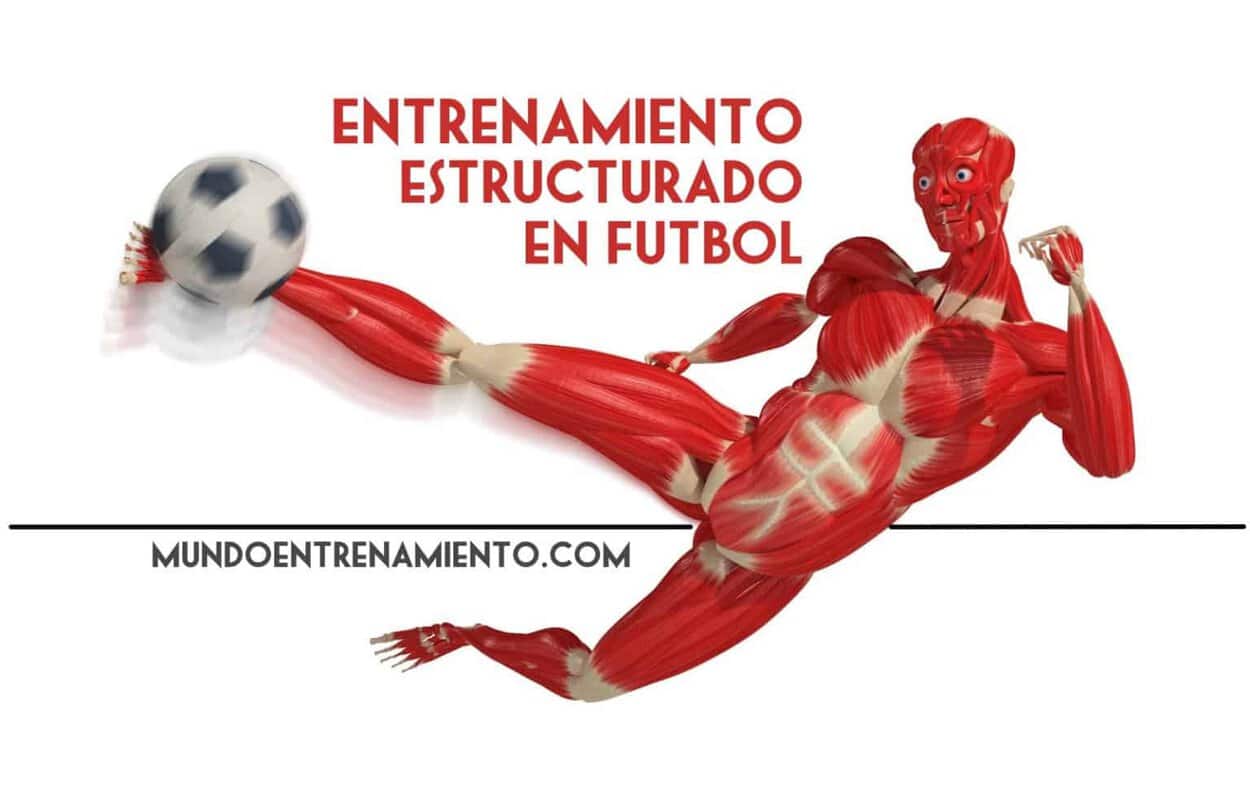This article talks about structured training in soccer, taking as reference the main authors of this type of training, and presents a proposal for planning a competitive microcycle following this approach to apply in our team.
Training planning
Description and justification of the type of planning to be used.
Currently, there are different styles and methodologies of training planning, one of them is structured training in soccer (1). The structured training mainly focuses on what happens inside the athlete. The athlete must analyze what happens in their competitive environment and from there adapt and seek solutions to achieve the goal. Soccer is a sport with a very variable environment, and the best way to train and prepare our players will be by providing uncertainty and variability to the training. Another important characteristic is the interrelation of all the structures that make up the training, (figure 1), in the tasks. Proposing tasks, emphasizing a specific structure but involving the others, will allow creating training situations very similar to the competitive reality where the player/team can interpret and seek the most appropriate solutions to their characteristics, improving individually and collectively.

The structured training divides the type of tasks or work to be done within each session into general, directed, special, and competitive work, and these go from less to more specificity. Depending on the time of the season (preseason, playoff…), the opponent (first classified, lower zone team), the day of the week (regenerative session, extensive dynamic session, etc…) we will give more importance and prominence to one type of exercises or others, with special and competitive work being the most used once the competition has started.
Enumeration, description, and justification of the different types of microcycles applied in a season based on structured training in soccer
The microcycles proposed by structured training in soccer are: Preparatory microcycle, directed transformation microcycle, special transformation microcycle, maintenance microcycle, and competitive microcycle.
The preseason serves to prepare the players and the team for what will come next, which will be the first league match. The players come from a transitional vacation period, and the main objective will be to achieve a high level of fitness for the start of the competition.
During the preseason, preparatory microcycles and transformation microcycles will be used.
- Preparatory microcycle: These will be the initial microcycles to start with the team, and generic and general tasks will be used. Introductory strength work to “remind” the muscles of the type of effort to be made.
- Directed transformation microcycle: Predominance of general and directed sessions. They are usually used during the last weeks of the preseason or in phases where the competition stops, such as the Christmas period.
- Specific transformation microcycle: Predominance of directed and special sessions. Advisable at the start of the competitive phase or when our opponent presents a much lower or much higher level than ours. It can be used in the last week of the preseason to link it with the first league match. Once the competition has started, unless in specific cases like the one mentioned above, maintenance and competitive microcycles will be used.
- Maintenance microcycle: The microcycle that will be used the most throughout the season. Priority will be given to directed and special tasks. The objective will be to maintain the highest possible fitness level of all the players on the team and the team as a whole.
- Competitive microcycle: This microcycle will be used in weeks where we have the most important matches of the season, such as a direct rival, a final, etc…
Example of a typical microcycle during the competition period
Let’s see a proposal for a competitive microcycle according to the training volume applied in the different sessions of the week and the type of work we can perform in the different structures (figures 2, 3, and 4).

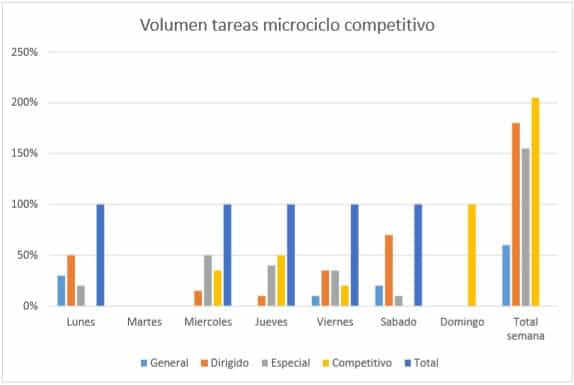
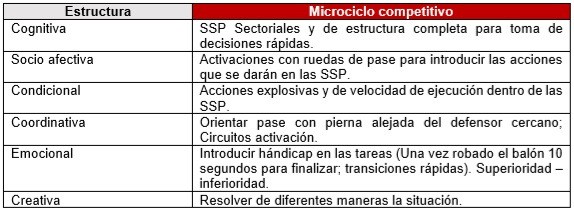
Methodology of structured training
Description of the type of tasks used to design the sessions
The task is the direct communication channel with the athlete where we manage to interact with them, modify motor, cognitive, conditional schemes, and change behaviors to shape the optimization process (4). To adequately model the fitness level of our team, it is necessary to order and combine in the microcycle the loads of different levels of specificity (6). During a competitive microcycle, it will be preferable to use specific and competitive tasks in a higher percentage.
Training at these levels of specificity aims to train cognitive processes as well as optimize the technical and tactical responses established by our game model despite the different levels of fatigue experienced by the players (6). The degree of intensity and accumulated fatigue within the tasks will be a very important parameter to control according to what we seek in the microcycle. In this case, we will seek greater intensity and a decrease in volume to reach a high fitness state for the match. The following chart shows us the characteristics that tasks focused on a competitive specificity level should present (figure 5).
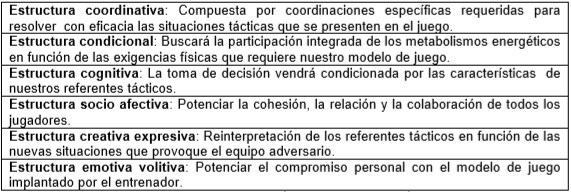
Example of tasks that can be used in this type of microcycle:
- Passing wheels: Ideal tasks to perform during activation or the day before the competition depending on their orientation. They can serve to work on the technical aspects of the players and to introduce automatisms that later the players can use to solve the different game actions that arise. The passing wheels will be oriented to our team’s game model.
- Chained actions: For recovery days the day before the match, with finishing.
- Possessions: Rondos and possessions as contextualized as possible.
- SSP Preferential simulator situations: Simulator situation of the competitive event that we manipulate to facilitate or overstimulate the player’s accessibility threshold, giving preference to those aspects that interest us at that moment (4). These can be of sectorial structure or complete structure.
- Regenerative and prevention work: Aerobic and low-intensity work for the day after the match. Individual and collective preventive work circuits, stretching, recreational games.
- Activation and introduction circuits: Circuits with or without a ball to perform a progressive activation to the task and an introduction to the conditional and coordinative aspect that will be worked on that day.
Some tasks to use during the competitive period







Assessment and control
Proposal for assessment and control of the load (conditional, cognitive, psychological…), to be applied in the team
The load is a number that indicates to the coach the relationship between the quality and quantity of the tasks they design and apply to their athletes. It is the main responsible for activating or deactivating the organism’s adaptive process (5).
Most factors oriented to the assessment of the load in sports refer to physiological parameters (heart rate, lactic acid, oxygen consumption, etc…). In situational sports where the level of difficulty and complexity of the tasks is higher, with a very varied coordinative structure closely related to the decision-making process, it is necessary to consider a greater number of elements to find the load, such as the cognitive or socio-affective effort of the tasks. For this reason, we will have to consider the interaction of all possible variables in the control of the load of our players (2, 7).
The control of the training load in cycles longer than a week is difficult to perform, which is why in team sports, training microcycles are carried out.
We must consider all the structures and create more or less complex tasks, with greater or lesser player interaction, with greater or lesser volume, intensity, rest, depending on the day of the week we are in, seeking to modulate the players’ fitness state. It is necessary to consider the type of actions and conditional requirements that occur in the task, taking as variables the tension, duration, and speed (2). According to Solé (6) “When we program the microcycle, one of the criteria used is the purpose that each session will have and what magnitude of the load will be required to achieve it.” Taking this into consideration, to control the load we propose in training, we must know what type of training to perform according to the day we are in, recovery, intensive dynamics, or extensive dynamics (figure 6).
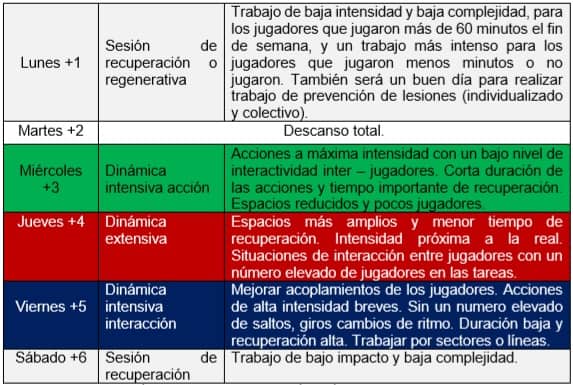
Regarding internal factors, a good indicator of the impact of the load on the footballer can be the analysis of the subjective perception of effort (RPE) or its different variants such as CR10 or Solé’s load units (5) that perform a more specific load control.
We can also be helped by conducting tests during the season using chronojump technology, with jump tests and the linear encoder to control power in more generic and general work executions.
Load units (5): It consists of taking as reference the subjective perception of effort of our athletes, about 30 minutes after finishing the session, and also giving the tasks we perform in training a level of specificity according to their orientation
- General 1-2
- Specific general 3-4
- Directed specific 5-6
- Special specific 7-8
- Competitive 9-10
Evaluating in this way, internal and external factors of the training load.
VOLUME (min) X CR10 X SPECIFICITY LEVEL
LOAD U. = ——————————————————————
50
Chronojump Bosco system (8): It is a software that allows intra-session and inter-session comparisons by recording changes produced by specific training. It has different materials that will allow us to evaluate different manifestations and perform different tests. The most interesting for our planning will be the contact platform and the linear encoder. Through the contact platform, we can perform a battery of jumps to our players at specific moments of the season and know the type of efforts that best adapt to this player (possibilities of applying them on the playing field), prevent injuries, and their evolution after a training period (figure 7).
With the use of the linear encoder, we can better monitor and individualize the more generic training of our athletes, offering immediate feedback and working at the appropriate levels of strength and power (figure 8).
*This load control proposal is for teams with few resources (that do not have GPS equipment, for example).
Bibliographic references
- Cabrera, I (2017). Planificació de l’entrenament en fútbol. Apunts Máster RETAN, Barcelona.
- Pol, R (2017). La preparación ¿física? En el fútbol. Pontevedra, MCSports,
- Seirullo, F (2017). El entrenamiento en los deportes de equipo. Pallejá. Mastercede.
- Serrés, R (2017). La tarea: pieza fundamental del entrenamiento estructurado. En F.
- Seirullo, El entrenamiento en los deportes de equipo (pp.196-211). Pallejà. Mastercede.
- Solé, J (2008). Teoría del entrenamiento deportivo. Barcelona, SicropatSport.
- Solé, (2017a). ¿Cómo se expresa la fuerza en el tiempo?. En F. Seirullo, El entrenamiento en los deportes de equipo (pp.196-211). Pallejà. Mastercede.
- Solé, J (2017b). Optimització de l’entrenament i control de les capacitats condicionals. Apunts Máster RETAN, Barcelona.
Article author: Joan Huesca Vancell | Graduate in Physical Activity and Sports Sciences
